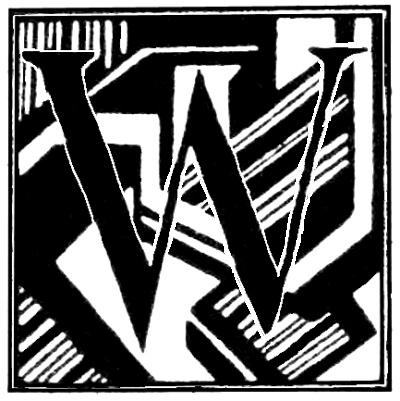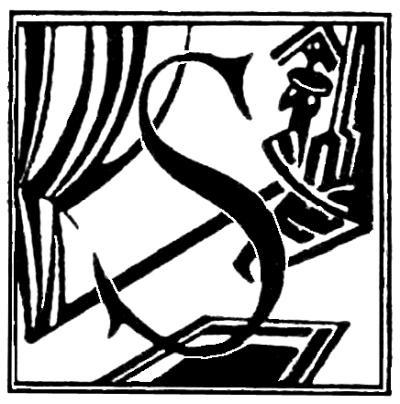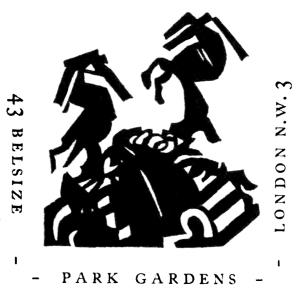Topic
Solution Manual for College Physics Volume 2 11th Edition by Serway and Vuille ISBN 13059655239781305965522
Full link download
Solution Manual:
https://testbankpack.com/p/solution-manual-for-college-physics-volume-2-11thedition-by-serway-and-vuille-isbn-1305965523-9781305965522/
Topic 15
Electric Forces and Fields
QUICK QUIZZES
15.1 Choice (b). Object A must have a net charge because two neutral objects do not attract each other. Since object A is attracted to positively-charged object B, the net charge on A must be negative.
15.2 Choice (b). By Newton’s third law, the two objects will exert forces having equal magnitudes but opposite directions on each other
15.3 Choice (c). The electric field at point P is due to charges other than the test charge. Thus, it is unchanged when the test charge is altered. However, the direction of the force this field exerts on the test change is reversed when the sign of the test charge is changed.
15.4 Choice (a). If a test charge is at the center of the ring, the force exerted on the test charge by charge on any small segment of the ring will be balanced by the force exerted by charge on the diametrically opposite
segment of the ring. The net force on the test charge, and hence the electric field at this location, must then be zero.
15.5 Choices (c) and (d). The electron and the proton have equal magnitude charges of opposite signs. The forces exerted on these particles by the electric field have equal magnitude and opposite directions. The electron experiences an acceleration of greater magnitude than does the proton because the electron’s mass is much smaller than that of the proton.
15.6 Choice (a). The field is greatest at point A because this is where the field lines are closest together. The absence of lines at point C indicates that the electric field there is zero.
15.7 Choice (c). When a plane area A is in a uniform electric field E, the flux through that area is ΦE = EA cos θ, where θ is the angle the electric field makes with the line normal to the plane of A. If A lies in the xy-plane and E is in the z-direction, then θ = 0° and ΦE= EA = (5.00 N/C)(4.00 m2) = 20.0 N m2/C.
15.8 Choice (b). If θ = 60° in Quick Quiz 15.7 above, then ΦE = EA cos θ which yields ΦE = (5.00 N/C)(4.00 m 2)cos (60°) = 10.0 N ⋅ m 2/C.
15.9 Choice (d). Gauss’s law states that the electric flux through any closed surface is equal to the net enclosed charge divided by the permittivity of free space. For the surface shown in Figure 15.28, the net enclosed charge
is Q = 6 C, which gives ΦE = Q/e0 = (6 C)/e0.
15.10 Choices (b) and (d). Since the net flux through the surface is zero, Gauss’s law says that the net change enclosed by that surface must be zero as stated in (b) Statement (d) must be true because there would be a net flux through the surface if more lines entered the surface than left it (or viceversa).
ANSWERS TO EVEN NUMBERED CONCEPTUAL QUESTIONS
15.2 (a) False. Electric charge can only be transferred in multiples of the fundamental charge +e
(b) True.
(c) False. All electrons have an electric charge of e.
15.4 (a) Removing charge Q from object A leaves it with a net positive charge of +Q. Object B acquires a net charge Q so that A and B are oppositely charged and the Coulomb force, proportional to QAQB = Q2 , is attractive.
(b) After another transfer of Q from A to B, QA = +2Q and QB = 2Q so that QAQB = 4Q2 and Fnew/F0 = 4.
(c) If B is neutralized so that QB = 0, the Coulomb force is zero and Fnew/F0 = 0.
15.6 No. Object A might have a charge opposite in sign to that of B, but it also might be neutral. In this latter case, object B causes object A to be polarized, pulling charge of the sign opposite the change on B toward the near face of A and pushing an equal amount of charge of the same sign as that on B toward the far face. Then, due to difference in distances, the force of attraction exerted by B on the induced charge of opposite sign is slightly larger than the repulsive force exerted by B on the induced charge of like sign. Therefore, the net force on A is toward B
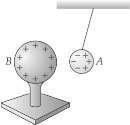
15.8
(a) Yes. The positive charges create electric fields that extend in all directions from those charges. The total field at point A is the vector sum of the individual fields produced by the charges at that point.
(b) No, because there are no field lines emanating from or converging on point A.
(c) No. There must be a charged object present to experience a force.
15.10 Electric field lines start on positive charges and end on negative charges. Thus, if the fair-weather field is directed into the ground, the ground must have a negative charge.
15.12 To some extent, a television antenna will act as a lightning rod on the house. If the antenna is connected to the Earth by a heavy wire, a lightning discharge striking the house may pass through the metal support rod and be safely carried to the Earth by the ground wire.
15.14 (a) If the charge is tripled, the flux through the surface is also tripled because the net flux is proportional to the charge inside the surface.
(b) The flux remains constant when the volume changes because the surface surrounds the same amount of charge, regardless of its volume.
(c) The flux does not change when the shape of the closed surface changes.
(d) The flux through the closed surface remains unchanged as the charge inside the surface is moved to another location inside that surface.
(e) The flux is zero because the charge inside the surface is zero. All of
Another random document with no related content on Scribd:
Some two or three, who will not touch the bloom
That is rubbed and questioned in the concert room.”
—And so the conversation slips
Among velleities and carefully caught regrets
Through attenuated tones of violins
Mingled with remote cornets
And begins.
“You do not know how much they mean to me, my friends, And how, how rare and strange it is, to find
In a life composed so much, so much of odds and ends,
(For indeed I do not love it ... you knew? you are not blind!
How keen you are!)
To find a friend who has these qualities,
Who has, and gives
Those qualities upon which friendship lives.
How much it means that I say this to you—
Without these friendships—life, what cauchemar!”
Among the windings of the violins
And the ariettes
Of cracked cornets
Inside my brain a dull tom-tom begins
Absurdly hammering a prelude of its own, Capricious monotone
That is at least one definite “false note”.
—Let us take the air, in a tobacco trance, Admire the monuments
Discuss the late events,
Correct our watches by the public clocks.
Then sit for half an hour and drink our bocks.
II
Now that lilacs are in bloom
She has a bowl of lilacs in her room
And twists them in her fingers while she talks.
“Ah, my friend, you do not know, you do not know
What life is, you who hold it in your hands;”
(Slowly twisting the lilac stalks)
“You let it flow from you, you let it flow And youth is cruel, and has no remorse And smiles at situations which it cannot see.”
I smile, of course, And go on drinking tea.
“Yet with these April sunsets, that somehow recall
My buried life, and Paris in the Spring, I feel immeasurably at peace, and find the world
To be wonderful and youthful, after all.”
The voice returns like the insistent out-of-tune
Of a broken violin on an August afternoon:
“I am always sure that you understand
My feelings, always sure that you feel, Sure that across the gulf you reach your hand.
You are invulnerable, you have no Achilles’ heel. You will go on, and when you have prevailed
You can say: at this point many a one has failed.
But what have I, but what have I, my friend, To give you, what can you receive from me?
Only the friendship and the sympathy Of one about to reach her journey’s end.
I shall sit here, serving tea to friends....”
I take my hat: how can I make a cowardly amends
For what she has said to me?
You will see me any morning in the park
Reading the comics and the sporting page.
Particularly I remark
An English countess goes upon the stage. A Greek was murdered at a Polish dance,
Another bank defaulter has confessed.
I keep my countenance,
I remain self-possessed
Except when a street piano, mechanical and tired Reiterates some worn-out common song
With the smell of hyacinths across the garden Recalling things that other people have desired.
Are these ideas right or wrong?
III
The October night comes down; returning as before
Except for a slight sensation of being ill at ease I mount the stairs and turn the handle of the door
And feel as if I had mounted on my hands and knees.
“And so you are going abroad; and when do you return?
But that’s a useless question.
You hardly know when you are coming back, You will find so much to learn.”
My smile falls heavily among the bric-à-brac.
“Perhaps you can write to me.”
My self-possession flares up for a second; This is as I had reckoned.
“I have been wondering frequently of late (But our beginnings never know our ends!)
Why we have not developed into friends.”
I feel like one who smiles, and turning shall remark
Suddenly, his expression in a glass.
My self-possession gutters; we are really in the dark.
“For everybody said so, all our friends, They all were sure our feelings would relate So closely! I myself can hardly understand. We must leave it now to fate.
You will write, at any rate.
Perhaps it is not too late.
I shall sit here, serving tea to friends.”
And I must borrow every changing shape
To find expression ... dance, dance
Like a dancing bear,
Cry like a parrot, chatter like an ape.
Let us take the air, in a tobacco trance—
Well! and what if she should die some afternoon,
Afternoon grey and smoky, evening yellow and rose;
Should die and leave me sitting pen in hand
With the smoke coming down above the house-tops;
Doubtful, for quite a while
Not knowing what to feel or if I understand
Or whether wise or foolish, tardy or too soon ...
Would she not have the advantage, after all?
This music is successful with a “dying fall”
Now that we talk of dying—
And should I have the right to smile?
PRELUDES

IAnd newspapers from vacant lots; The showers beat
On broken blinds and chimney-pots, And at the corner of the street
A lonely cab-horse steams and stamps. And then the lighting of the lamps.
II
The morning comes to consciousness Of faint stale smells of beer
From the sawdust-trampled street
�� winter evening settles down
With smell of steaks in passageways. Six o’clock.
The burn-out ends of smoky days. And now a gusty shower wraps
The grimy scraps Of withered leaves about your feet
With all its muddy feet that press
To early coffee-stands.
With the other masquerades
That time resumes,
One thinks of all the hands
That are raising dingy shades
In a thousand furnished rooms.
III
You tossed a blanket from the bed, You lay upon your back, and waited;
You dozed, and watched the night revealing
The thousand sordid images
Of which your soul was constituted;
They flickered against the ceiling.
And when all the world came back
And the light crept up between the shutters,
And you heard the sparrows in the gutters,
You had such a vision of the street
As the street hardly understands;
Sitting along the bed’s edge, where
You curled the papers from your hair, Or clasped the yellow soles of feet
In the palms of both soiled hands.
IV
His soul stretched tight across the skies
That fade behind a city block, Or trampled by insistent feet
At four and five and six o’clock;
And short square fingers stuffing pipes, And evening newspapers, and eyes
Assured of certain certainties,
The conscience of a blackened street
Impatient to assume the world.
I am moved by fancies that are curled Around these images, and cling: The notion of some infinitely gentle Infinitely suffering thing.
Wipe your hand across your mouth, and laugh; The worlds revolve like ancient women Gathering fuel in vacant lots.
RHAPSODY ON A WINDY NIGHT

����� o’clock. Along the reaches of the street
Held in a lunar synthesis
Whispering lunar incantations
Dissolve the floors of the memory
And all its clear relations, Its divisions and precisions, Every street lamp that I pass
Beats like a fatalistic drum, And through the spaces of the dark Midnight shakes the memory
As a madman shakes a dead geranium.
Half-past one.
The street lamp sputtered,
The street lamp muttered,
The street lamp said, “Regard that woman
Who hesitates toward you in the light of the door
Which opens on her like a grin.
You see the border of her dress
Is torn and stained with sand, And you see the corner of her eye
Twists like a crooked pin.”
The memory throws up high and dry
A crowd of twisted things;
A twisted branch upon the beach
Eaten smooth and polished
As if the world gave up
The secret of its skeleton, A broken spring in a factory yard, Rust that clings to the form that the strength has left Hard and curled and ready to snap.
Half-past two,
The street lamp said,
“Remark the cat which flattens itself in the gutter, Slips out its tongue
And devours a morsel of rancid butter.”
So the hand of a child, automatic, Slipped out and pocketed a toy that was running along the quay.
I could see nothing behind that child’s eye.
I have seen eyes in the street
Trying to peer through lighted shutters, And a crab one afternoon in a pool,
An old crab with barnacles on his back, Gripped the end of a stick which I held him.
Half-past three,
The lamp sputtered,
The lamp muttered in the dark.
The lamp hummed:
“Regard the moon,
La lune ne garde aucune rancune, She winks a feeble eye,
She smiles into corners.
She smoothes the hair of the grass.
The moon has lost her memory.
A washed-out smallpox cracks her face, Her hand twists a paper rose,
That smells of dust and old Cologne,
She is alone
With all the old nocturnal smells
That cross and cross across her brain.
The reminiscence comes
Of sunless dry geraniums
And dust in crevices, Smells of chestnuts in the streets, And female smells in shuttered rooms, And cigarettes in corridors And cocktail smells in bars.”
The lamp said
“Four o’clock,
Here is the number on the door
Memory!
You have thè key
The little lamp spreads a ring on the stair, Mount.
The bed is open: the tooth-brush hangs on the wall, Put your shoes at the door, sleep, prepare for life.”
The last twist of the knife.
MORNING AT THE WINDOW

Twisted faces from the bottom of the street, And tear from a passer-by with muddy skirts An aimless smile that hovers in the air And vanishes along the level of the roofs.
��� are rattling breakfast plates in basement kitchens And along the trampled edges of the street I am aware of the damp souls of housemaids Sprouting despondently at area gates.
The brown waves of fog toss up to me
CONVERSATION GALANTE
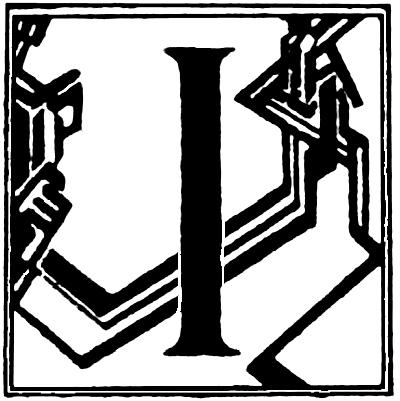
�������: “Our sentimental friend the moon!
Or possibly (fantastic, I confess)
It may be Prester John’s balloon Or an old battered lantern hung aloft
To light poor travellers to their distress.”
She then: “How you digress!”
And I then: “Some one frames upon the keys That exquisite nocturne, with which we explain The night and moonshine; music which we seize To body forth our own vacuity.”
She then: “Does this refer to me?”
“Oh no, it is I who am inane.”
“You, madam, are the eternal humorist, The eternal enemy of the absolute, Giving our vagrant moods the slightest twist! With your air indifferent and imperious At a stroke our mad poetics to confute—”
And—“Are we then so serious?”
AUNT HELEN

��� H���� S������� was my maiden aunt, Miss Helen Slingsby was my maiden aunt, And lived in a small house near a fashionable square
Cared for by servants to the number of four. Now when she died there was silence in heaven
And silence at her end of the street.
The shutters were drawn and the undertaker wiped his feet
—
He was aware that this sort of thing had occurred before.
The dogs were handsomely provided for, But shortly afterwards the parrot died too.
The Dresden clock continued ticking on the mantelpiece, And the footman sat upon the dining-table
Holding the second house-maid on his knees—
Who had always been so careful while her mistress lived.

